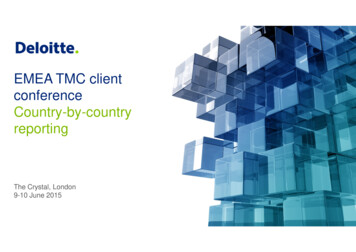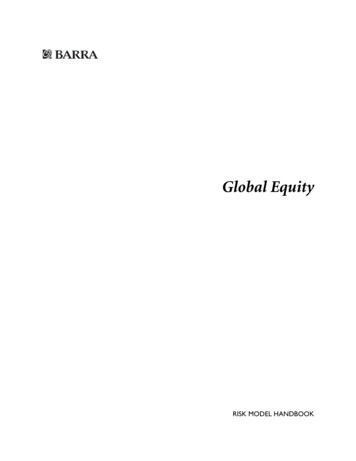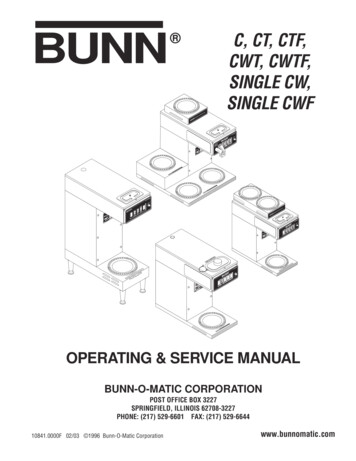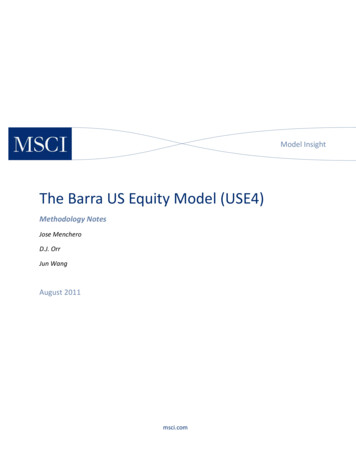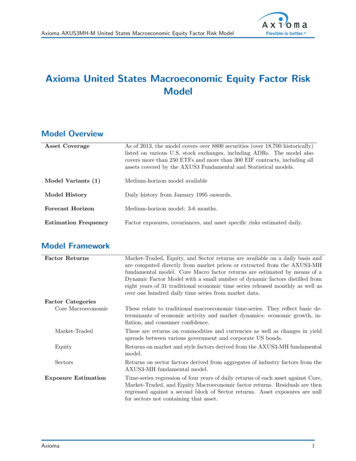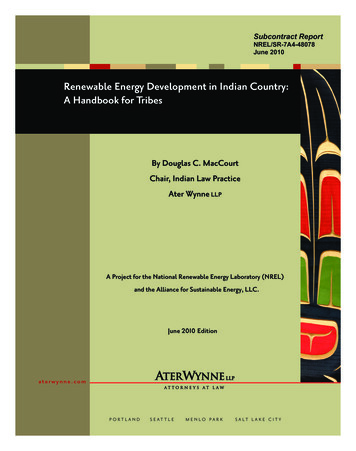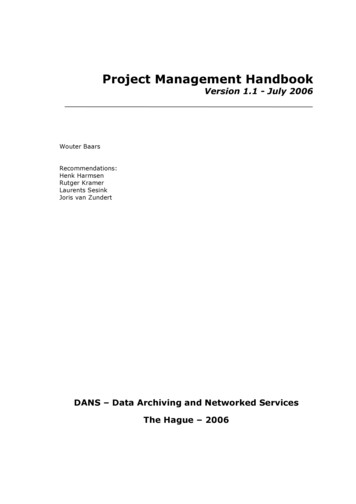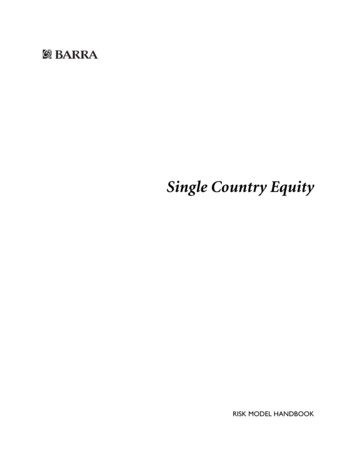
Transcription
Single Country EquityRISK MODEL HANDBOOK
BARRA makes no warranty, express or implied, regarding its equity risk models or any results to be obtained from the use of itsequity risk models. BARRA EXPRESSLY DISCLAIMS ALL WARRANTIES, EXPRESS OR IMPLIED, REGARDING ITS EQUITYRISK MODELS, INCLUDING BUT NOT LIMITED TO ALL IMPLIED WARRANTIES OF MERCHANTABILITY AND FITNESSFOR A PARTICULAR PURPOSE OR USE OR THEIR EQUIVALENTS UNDER THE LAWS OF ANY JURISDICTION. AlthoughBARRA intends to obtain information and data from sources it considers to be reasonably reliable, the accuracy andcompleteness of such information and data are not guaranteed and BARRA will not be subject to liability for any errors oromissions therein. Accordingly, such information and data, BARRA’s equity risk models, and their output are not warranted to befree from error. BARRA does not warrant that its equity risk models will be free from unauthorized hidden programs introducedinto its equity risk models without BARRA's knowledge.Copyright BARRA, Inc. 1998. All rights reserved.0112 O 03/98
ContentsAbout BARRA . . . . . . . . . . . . . . . . . . . . . . . . . . . . . . . . . . . . 1A pioneer in risk management . . . . . . . . . . . . . . . . . . . . . . . . . . . . . 1Introduction . . . . . . . . . . . . . . . . . . . . . . . . . . . . . . . . . . . . . 3In this handbook. . . . . . . . . . . . . . . . . . . . . . . . . . . . . . . . . . . . . . . . . 3Further references . . . . . . . . . . . . . . . . . . . . . . . . . . . . . . . . . . . . . . . 4Books . . . . . . . . . . . . . . . . . . . . . . . . . . . . . . . . . . . . . . . . . . . . . . . 41. Why Risk is Important . . . . . . . . . . . . . . . . . . . . . . . . . . . 5The goal of risk analysis. . . . . . . . . . . . . . . . . . . . . . . . . . . . . . . . . . . 62. Defining Risk . . . . . . . . . . . . . . . . . . . . . . . . . . . . . . . . . . 9Some basic definitions . . . . . . . . . . . . . . . . . . . . . . . . . . . . . . . . . . . . 9Risk measurement . . . . . . . . . . . . . . . . . . . . . . . . . . . . . . . . . . . . . . .11An example . . . . . . . . . . . . . . . . . . . . . . . . . . . . . . . . . . . . . . . . . . . . .11Risk reduction through diversification . . . . . . . . . . . . . . . . . . . . . 12Drawbacks of simple risk calculations . . . . . . . . . . . . . . . . . . . . . 14Evolution of concepts . . . . . . . . . . . . . . . . . . . . . . . . . . . . . . . . . . . 143. Modeling and Forecasting Risk . . . . . . . . . . . . . . . . . . . 19What are MFMs? . . . . . . . . . . . . . . . . . . . . . . . . . . . . . . . . . . . . . . . 19How do MFMs work? . . . . . . . . . . . . . . . . . . . . . . . . . . . . . . . . . . . 19Advantages of MFMs . . . . . . . . . . . . . . . . . . . . . . . . . . . . . . . . . . . . 20A simple MFM . . . . . . . . . . . . . . . . . . . . . . . . . . . . . . . . . . . . . . . . . 21Model mathematics . . . . . . . . . . . . . . . . . . . . . . . . . . . . . . . . . . . . . 23Risk prediction with MFMs . . . . . . . . . . . . . . . . . . . . . . . . . . . . . . 24i
4. Modern Portfolio Management and Risk . . . . . . . . . . . 29Portfolio management—two types . . . . . . . . . . . . . . . . . . . . . . . . 29Passive management . . . . . . . . . . . . . . . . . . . . . . . . . . . . . . . . . 29Active management . . . . . . . . . . . . . . . . . . . . . . . . . . . . . . . . . . 30Decomposing risk. . . . . . . . . . . . . . . . . . . . . . . . . . . . . . . . . . . . . . . 32Total Risk Decomposition . . . . . . . . . . . . . . . . . . . . . . . . . . . . 32Systematic-Residual Risk Decomposition . . . . . . . . . . . . . . . 33Active Risk Decomposition . . . . . . . . . . . . . . . . . . . . . . . . . . . 34Active Systematic-Active Residual Risk Decomposition . . . 35Summary of risk decomposition . . . . . . . . . . . . . . . . . . . . . . . . . . 36Performance attribution . . . . . . . . . . . . . . . . . . . . . . . . . . . . . . . . . 36Summary . . . . . . . . . . . . . . . . . . . . . . . . . . . . . . . . . . . . . . . . . . . . . . 375. BARRA Multiple-Factor Modeling . . . . . . . . . . . . . . . . . 39Overview . . . . . . . . . . . . . . . . . . . . . . . . . . . . . . . . . . . . . . . . . . . . . . 39Descriptor selection and testing. . . . . . . . . . . . . . . . . . . . . . . . . . . 42Descriptor standardization . . . . . . . . . . . . . . . . . . . . . . . . . . . . . . . 42Risk index formulation . . . . . . . . . . . . . . . . . . . . . . . . . . . . . . . . . . 43Industry allocation . . . . . . . . . . . . . . . . . . . . . . . . . . . . . . . . . . . . . . 43Factor return estimation . . . . . . . . . . . . . . . . . . . . . . . . . . . . . . . . . 44Covariance matrix calculation . . . . . . . . . . . . . . . . . . . . . . . . . . . . 44Exponential weighting . . . . . . . . . . . . . . . . . . . . . . . . . . . . . . . 45Computing market volatility:Extended GARCH models. . . . . . . . . . . . . . . . . . . . . . . . . . . . 46Specific risk modeling . . . . . . . . . . . . . . . . . . . . . . . . . . . . . . . . . . . 47Overview . . . . . . . . . . . . . . . . . . . . . . . . . . . . . . . . . . . . . . . . . . . 47Methodology . . . . . . . . . . . . . . . . . . . . . . . . . . . . . . . . . . . . . . . 48Modeling the average level of specific risk . . . . . . . . . . . . . . . 48Modeling the relative level of specific risk . . . . . . . . . . . . . . . 49Estimating the scaling coefficients . . . . . . . . . . . . . . . . . . . . . 50Final specific risk forecast. . . . . . . . . . . . . . . . . . . . . . . . . . . . . 50Updating the model . . . . . . . . . . . . . . . . . . . . . . . . . . . . . . . . . . . . . 50Comparison of risk model features . . . . . . . . . . . . . . . . . . . . . . . . 51iiSingle Country Equity Risk Model Handbook
Glossary . . . . . . . . . . . . . . . . . . . . . . . . . . . . . . . . . . . . . . . 53Index . . . . . . . . . . . . . . . . . . . . . . . . . . . . . . . . . . . . . . . . . 63Contributors . . . . . . . . . . . . . . . . . . . . . . . . . . . . . . . . . . . . 68Contentsiii
ivSingle Country Equity Risk Model Handbook
About BARRAIn recent years the investment management industry has adjusted tocontinuing changes—theoretical advances, technological developments, and market growth. To address these challenges, investmentmanagers and financial institutions require the most advanced andpowerful analytical tools available.A pioneer in risk managementAs the leading provider of global investment decision tools, BARRAhas responded to these industry changes by providing quantitativeproducts and services that are both flexible and efficient. Since ourfounding in 1975, BARRA has been a leader in modern financialresearch and techniques.Initially, our services focused on risk analysis in equity markets. OurU.S. Equity Model set a standard of accuracy that BARRA continuesto follow. BARRA uses the best data available to develop econometric financial models. In turn, these models are the basis of softwareproducts designed to enhance portfolio performance throughreturns forecasting, risk analysis, portfolio construction, transactioncost analysis, and historical performance attribution.In 1979, BARRA expanded into the fixed income area with therelease of U.S. bond valuation and risk models. In the mid-1980s wedeveloped a global tactical asset allocation system: The BARRAWorld Markets Model . More recently, the Total Plan Risk approach was developed to provide multi-asset-class value-at-risk(VAR) analyses.BARRA now has offices around the world and products that covermost of the world’s traded securities. By 1997, our clients comprisedapproximately 1,200 financial institutions worldwide managing over 7 trillion in assets. They rely on BARRA’s investment technologyand consulting services to strengthen their financial analysis andinvestment decision-making.1
2Single Country Equity Risk Model Handbook
IntroductionIn this handbookThis handbook contains a general discussion of equity risk andreturn, and the methods BARRA uses to model portfolio risk.Chapter 1. Why Risk is Important gives an overview of why financialprofessionals should care about risk.Chapter 2. Defining Risk outlines the basic statistical concepts underlying risk analysis, and traces the history of equity risk theory.Chapter 3. Modeling and Forecasting Risk discusses the applicationof multiple-factor modeling (MFM) to the equity risk analysis problem.Chapter 4. Modern Portfolio Management and Risk relates the various types of active and passive equity management to the use of arisk model.Chapter 5. BARRA Multiple-Factor Modeling details the process ofcreating and maintaining a BARRA equity MFM.The Glossary and Index are useful resources for clarifying terminology and enhancing the handbook’s usefulness.3
Further referencesBARRA has a comprehensive collection of articles and other materials describing the models and their applications. To learn more aboutthe topics contained in this handbook, consult the following references or our extensive Publications Bibliography, which isavailable from BARRA offices and from our Web site athttp://www.barra.com.BooksAndrew Rudd and Henry K. Clasing, Modern Portfolio Theory: ThePrinciples of Investment Management, Orinda, CA, Andrew Rudd,1988.Richard C. Grinold and Ronald N. Kahn: Active Portfolio Management: Quantitative Theory and Applications, Probus Publishing, Chicago, IL, 1995.4Single Country Equity Risk Model Handbook
1. Why Risk is ImportantSuperior investment performance is the product of careful attentionto four elements: forming reasonable return expectations controlling risk so that the pursuit of opportunities remains tempered by prudence controlling costs so that investment profits are not dissipated inexcessive or inefficient trading controlling and monitoring the total investment process to maintain a consistent investment programThese four elements are present in any investment managementproblem, be it a strategic asset allocation decision, an actively managed portfolio, or an index fund—managed bottom-up or top-down,via traditional or quantitative methods.Figure 1-1Superior PerformanceThe Performance PyramidReturnForecastsRisk ControlProcessControlCost ControlIn a simpler view, return and risk are the protagonist and antagonistof investing. According to an old adage, the tradeoff between returnand risk is the tradeoff between eating well and sleeping well.Clearly, risk doesn’t just matter to quants!5
Ignoring risk is hazardous to your portfolio. The optimal strategyignoring risk places the entire portfolio in one stock. But no institutional investor follows this strategy. Hence risk considerations mustimpact every institutional portfolio. Unfortunately, they sometimesdo not impact them enough.We need not look far to find examples of financial disasters thatarose through lack of sufficient risk control. The debacles of OrangeCounty, Barings Bank, and the Piper Jaffray Institutional Government Income Fund all testify to the dangers of ignoring or poorlyunderstanding risk.But risk analysis is more than avoiding disasters—it can in factenhance opportunities. Peter Bernstein has argued that a lack ofunderstanding of risk holds back economic development. 1 Moderneconomic growth requires understanding risk.What are the expected returns to a new venture? What are the risks?Do the returns outweigh the risks? Can I hedge the risks? In moderneconomies, the future is not beyond management, not simply subjectto the whims of many gods. In fact, the period which marked thedevelopment of probability and statistics (during and after theRenaissance) also marked a time of profound growth in trade, exploration, and wealth. The ideas of risk management enabled the modern economic world, according to Bernstein. Risk analysis enhancedopportunities.While Bernstein’s argument may seem inspiring—though not of dayto-day relevance—in fact the goal of risk analysis is not to minimizerisk but to properly weigh risk against return. Sometimes risk analysis leads to taking more risk.The goal of risk analysisRisk is important. It is a critical element of superior investment performance. Good risk analysis should provide not only a number—aquantification of risk—but insight, especially insight into the “Performance Pyramid.”We have illustrated superior performance as a three-dimensionalobject. A single risk number is only one-dimensional. So what do wemean by insight?1. See Peter L. Bernstein, Against the Gods: The Remarkable Story of Risk,John Wiley & Sons, New York, 1996.6Single Country Equity Risk Model Handbook
Risk analysis should uncover not just overall risk, but the largest andsmallest bets in the portfolio. Do the largest bets correspond to thehighest expected returns? They should. If they do not, the portfolioisn’t properly balancing return and risk. Are the bets too large or toosmall? What is the “worst case” scenario? How will the portfoliocompare to its benchmark?Robust risk analysis can provide answers to all these questions aswell as insight to all investors. In this volume we will discuss the history and current practice of equity risk modeling for single countrymarkets. Other methods are used for different securities, such asbonds or currencies, and for different market structures, such as theglobal stock market. The underlying message is clear: The investorarmed with superior methods of assessing and controlling risk possesses a significant competitive edge in modern capital markets.1. Why Risk is Important7
8Single Country Equity Risk Model Handbook
2. Defining RiskSome basic definitionsIn an uncertain investment environment, investors bear risk. Risk isdefined as the total dispersion or volatility of returns for a securityor portfolio. Further, risk reflects uncertainty about the future.We will define risk as the standard deviation of the return. Risk is anabstract concept. A
risk model. Chapter 5. BARRA Multiple-Factor Modeling details the process of creating and maintaining a BARRA equity MFM. The Glossary and Index are useful resources for clarifying terminol-ogy and enhancing the handbook’s usefulness. 4 Single Country Equity Risk Model Handbook Further references BARRA has a comprehensive collection of articles and other materi-als describing the

